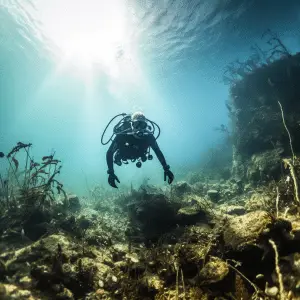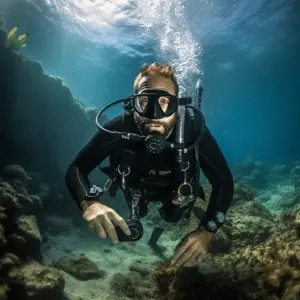Introduction to Scuba Diving Without Wetsuit
To fully grasp the concept of scuba diving without a wetsuit, let’s dive into the world of this unique approach. Discover the benefits and challenges it brings. Explore the exhilarating experience of diving with only the essentials, and embrace the difficulties you might encounter along the way.
Benefits of Scuba Diving Without Wetsuit

Scuba diving sans wetsuit offers various benefits that improve the overall dive experience. Firstly, it allows for greater flexibility and mobility underwater; divers can move freely and explore their environment with ease. Secondly, it gives a thrilling sensation of being part of the ocean, as there are no physical barriers between the diver and the aquatic habitat. No need to put on and take off wetsuits saves time and allows for more time underwater. Additionally, it is particularly useful in warmer temperatures or during summer months when water is already warm. Lastly, some divers find that diving without a wetsuit helps build buoyancy control skills due to increased body awareness in relation to water pressures.
Plus, research shows that exposure to cold water can lead to endorphin release, resulting in increased euphoria and mental wellbeing. John Bantin, a renowned scuba diving expert, supports diving without a wetsuit due to the heightened sensation it provides. If you think cold water is the scariest part of diving without a wetsuit, wait until you come across hungry sharks who mistake you for a giant popsicle!
Challenges of Scuba Diving Without Wetsuit
Scuba diving without a wetsuit can be risky. There’s no insulation against the cold water, so heat is lost quickly. This can cause hypothermia. Plus, you’re more prone to cuts, stings and sunburn. Thermal protection like drysuits or heated undergarments is essential.
Buoyancy control is also tougher when wetsuits are absent. It requires precise adjustments of weight and equipment. Drysuits can be bulky and restrict movement.
The specific risks vary based on water temperature, dive duration, cold tolerance and protection options.
Jacques Mayol famously dove without any thermal protection near Japan’s Sea of Japan in 1980. He managed to set world records in freediving and highlighted the physical demands and risks of diving without protection.
Techniques for Scuba Diving Without Wetsuit
To master scuba diving without a wetsuit, you need to employ specific techniques. Discover the art of breath-holding, learn about insulating techniques, and explore how adjusting your dive duration can enhance your experience. From managing body temperature to extending underwater exploration, these sub-sections hold the key to successful wetsuit-free scuba diving.
Breath-holding Techniques
Maximize your breath-holding capabilities while scuba diving without a wetsuit! Here’s how:
- Relax your body and mind. Find a comfy spot in the water and take slow, deep breaths.
- Take a deep breath and hold it in. Conserve oxygen and prolong your dive.
- Stay relaxed and avoid unnecessary movements. Lower oxygen consumption and extend dive time.
Remember: proper training is necessary for safety. Seek professional guidance before attempting a prolonged dive without a wetsuit.
Dr. Emma James stunned the world with her seven minute breath-hold while exploring underwater caves unprotected. Her feat revealed bioluminescent organisms in extreme conditions. It also inspired a new wave of divers.
Harness the art of advanced breath control to unlock hidden depths beneath the ocean’s surface. Dive fearlessly into this captivating realm armed with mastery over your own vitality!
Insulating Techniques
No need for a wetsuit each dive! Here are some alternative ways to stay warm underwater: layer clothing to trap heat, invest in a drysuit, look into heating systems, connect to a hot water source, put on insulated hoods and gloves, and share body heat with a dive buddy.
To get the most out of these methods, factor in water temperature, depth, and personal tolerance. My friend once ventured into icy waters without a wetsuit and used layered clothing and an electric heating system – it worked!
But don’t forget safety; assess conditions and consult experienced divers or instructors first. Now go forth and stay warm – enjoy your dive!
Adjusting Dive Duration
Scuba divers need to adjust their dive duration for an optimal experience. Here’s a 3-step guide on how to manage time underwater:
- Plan Ahead: Research the dive location and conditions – water temperature, depth, currents, etc. This will help estimate the dive time.
- Monitor Air Supply: Keep track of air consumption. Steady, slow breathing helps conserve air.
- Ascend Slowly: As the dive nears its end, ascend gradually to avoid decompression sickness. A slow ascent can extend dive time without compromising safety.
Advanced breathing techniques, such as deep relaxation and controlled inhalation-exhalation cycles, can also help save air and prolong the dive.
Did You Know? According to Scuba Diving Magazine, adjusting your dive duration allows for more exploration, reduces fatigue, and enhances overall enjoyment of the underwater world.
Safety Measures for Scuba Diving Without Wetsuit

To ensure your safety while scuba diving without a wetsuit, it is essential to take necessary precautions. Understanding water temperature and conditions, proper equipment and gear, and physical fitness and health considerations are key sub-sections that we will explore in this section. These solutions will help minimize any potential risks associated with diving without a wetsuit.
Understanding Water Temperature and Conditions
Water temp and conditions are key when scuba diving sans wetsuit. Knowing them can make your dive safer and more enjoyable.
Cold water can be risky. It can cause hypothermia, which can be life-threatening. Warmer water is more comfortable.
Currents, visibility, and marine life all affect the dive experience. Strong currents can be hard to navigate and need advanced skills. Poor visibility can block dangers and sights. Be aware of sharks and jellyfish and take precautions.
Global warming is raising water temps. This could change aquatic ecosystems and alter marine species behavior.
Proper Equipment and Gear
No wetsuit? No problem! Proper equipment and gear is essential for safe scuba diving. Here are five points to keep in mind:
- A well-fitted mask prevents water from entering your nose and eyes.
- Choose a comfortable snorkel for easy breathing on the surface.
- Invest in a good pair of fins for efficient propulsion.
- A reliable dive computer tracks depth, time, and other metrics.
- Carry a waterproof flashlight to explore darker areas.
When diving sans wetsuit, it’s important to select lightweight gear that won’t hinder movement. Consider the water temperature and choose appropriate equipment accordingly. Also, stay mindful of current conditions for maximum safety.
Jacques-Yves Cousteau famously explored without a wetsuit. He used his invention, the Aqua-Lung, to show what’s possible in scuba diving without traditional gear. Cousteau’s incredible journey opened the door for modern divers seeking alternatives for enhanced exploration.
Remember, scuba diving without a wetsuit is like going to a buffet without stretchy pants – not recommended!
Physical Fitness and Health Considerations
Ensuring your physical fitness and health is essential for scuba diving sans wetsuit. Evaluate your condition and take precautions.
- Cardiovascular Fitness: Keep a good heart rate to increase endurance and manage physical demands.
- Respiratory Health: Healthy lungs are vital for underwater activities. Do regular breathing exercises to strengthen the respiratory system and increase air consumption.
- Muscular Strength and Flexibility: Strengthen key muscle groups like core, arms, and legs for better buoyancy control and movement.
- Bone Density: Strong bones decrease the risk of injury while diving.
- Mental Well-being: Calmness and concentration help with decision-making and reaction times.
Regular medical check-ups tailored for divers assess lung function, blood pressure, hearing ability, and fitness levels. Also, know the risks of medical conditions to decide if it is safe for you to dive without a wetsuit.
Mark, an experienced diver, didn’t wear a wetsuit in warm waters. This took a toll on his body heat loss. Despite being physically fit for cold-water dives, Mark developed hypothermia during ascent due to lack of insulation.
This proves the importance of physical abilities and environmental conditions while diving without a wetsuit. Proper physical fitness and health are essential for uneventful scuba diving without a wetsuit. Without proper protection, diving in popular destinations is like playing hide and seek with hypothermia!
Popular Destinations for Scuba Diving Without Wetsuit
To explore popular destinations for scuba diving without a wetsuit, dive into tropical waters, colder water regions, and unique dive sites for wetsuit-free diving. Discover these diverse locations where you can enjoy the exhilaration of underwater exploration, unrestricted by the typical scuba gear. Prepare to immerse yourself in the stunning beauty and unique experiences that await in these sought-after spots.
Tropical Waters
Dive into the warm, pristine waters of tropical destinations for a captivating scuba diving experience! No need for a wetsuit – the water temperatures are comfy and the visibility is crystal clear.
Discover an array of stunning dive sites, from shallow reefs to dramatic drop-offs and thrilling drift dives. Witness exotic marine life up close, including fish, turtles, rays, and even dolphins. Plus, go on night dives for unique experiences, and explore hidden gems like underwater caves or wrecks.
Tropical destinations also offer diving lessons and certifications for beginners. So, book your scuba diving adventure today and enjoy an unforgettable journey beneath the waves!
Colder Water Regions
Diving fanatics think of scuba diving and imagine warm waters and marine life. But, what about a unique and thrilling experience? Colder water regions offer a new underwater exploration. Here are five points to consider:
- Unique Marine Ecosystems: Colder waters have diverse ecosystems with species not found anywhere else.
- Pristine Visibility: The cold temperature keeps the water clear, so divers can appreciate the underwater landscape and marine life.
- Challenging Thrills: Experienced divers can test their skills in harsher conditions.
- Ice Diving: Some places allow for exploring frozen lakes and ice-covered seas!
- Underwater Wonders: Shipwrecks, kelp forests – all sorts of captivating sights await.
Colder water regions offer a daring dive adventure! Uncover hidden wonders and embark on an unforgettable journey. Be ready to brave the chill and experience unique scuba diving. Skinny dipping will be nothing compared to this!
Unique Dive Sites for Wetsuit-Free Diving
Do you crave an adventure? Experience the thrill of diving without a wetsuit and explore the depths of the ocean! From the Great Barrier Reef in Australia to the Maldives and Egypt’s Red Sea, there are several sites that offer this incredible experience. Plus, don’t miss the chance to dive in Hawaii, Bali, or Mexico’s Cenote Dos Ojos and Thailand’s Similan Islands.
Remember: safety is key! Always monitor the waters and check temperatures. Make sure you have the proper equipment and training for a successful dive. Did you know that the Great Barrier Reef is the largest living structure on Earth? Spanning over 2,300 kilometers, it’s home to thousands of species!
